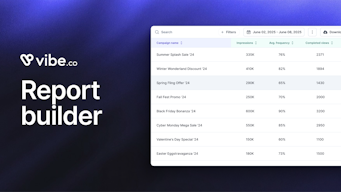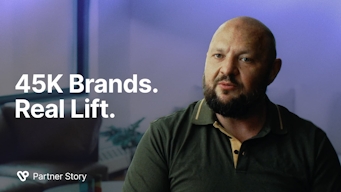VMVDP vs MVDP: '5' Key Differences To Know
Have you heard the terms VMVPD or MVPD and felt confused? Don’t worry. We’ve got you covered.
These are just two different ways to watch TV—streaming live channels online (VMVPD) or using traditional cable and satellite (MVPD).
Understanding the differences between these two is important, whether you're choosing how to watch TV or deciding where to advertise your business.
With streaming services rising in popularity, it’s a good time to explore both options.
In this blog, I’ll explain everything:
- What VMVPDs and MVPDs are.
- Their main differences and when to choose each one.
- How to decide which is best for watching TV or advertising.
- How tools like Vibe make advertising on vMVPD platforms easier by helping businesses target the right audience on premium streaming apps.
By the end, you’ll clearly understand how to make the right choice. Let’s get started!
vMVPD vs MVPD: 8 Key Differences
Let’s have a quick look at the differences between vMVPD and MVPD.
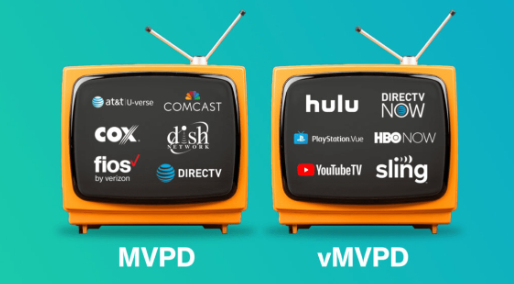
Let’s explore the eight key differences between vMVPDs and MVPDs. These differences will help you decide which one is a better fit for your needs.
| Feature | vMVPD | MVPD |
|---|---|---|
| How It Works | It streams TV online through the internet, similar to YouTube or Netflix. | It delivers TV via cable or satellite with physical infrastructure. |
| Devices | It works on phones, tablets, and smart TVs, offering flexibility. | It requires a cable box and connected TV, limiting mobility. |
| Flexibility | It allows you to watch anywhere with internet access. | It is limited to home setup, tied to a specific location. |
| Cost | It is affordable ($40–$70/month), with no extra fees and cancel anytime. | It is expensive ($100+/month), with hidden charges and long contracts. |
| Channels | It focuses on popular channels (e.g., ESPN, ABC, FOX) but may lack niche options. | It offers a wider variety, including niche and local channels. |
| Contracts | It doesn’t require long-term commitments; you can cancel anytime. | It requires long-term contracts, making switching difficult. |
| Internet Dependence | It needs a stable internet connection to work | It works without the internet, providing reliability. |
| Best For | It suits travelers, cost-conscious viewers, and tech-savvy individuals. | It is best for viewers who prioritize stability and niche channels. |
What Is a vMVPD?
A vMVPD, or Virtual Multichannel Video Programming Distributor, is a way to watch live TV using the internet.
Unlike traditional cable or satellite TV, you don’t need wires, boxes, or dishes to access your favorite channels. Everything streams directly to your devices—smartphones, tablets, or TVs.
It’s like having a portable TV service that works wherever you have a stable internet connection. Services like YouTube TV, Sling TV, and Hulu + Live TV are all examples of vMVPDs.
How Does a vMVPD Work?
Think about how you use apps like YouTube or Netflix. A vMVPD works similarly—it streams live channels, like sports or news, straight to your device.
It uses your internet connection instead of physical cables, so you can watch TV anywhere as long as you’re online.
Let’s understand it better with examples:
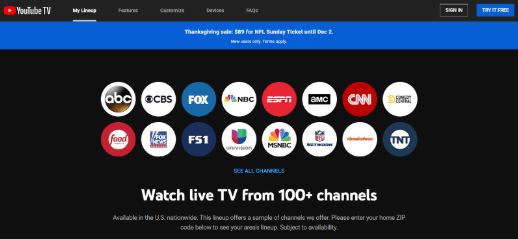
- YouTube TV lets you stream live channels like ABC, ESPN, and more.
- Sling TV gives you a mix of customizable channels, so you only pay for what you want.
- Hulu + Live TV combines its on-demand library with live TV streaming, all in one place.
Let me share an example with you. A vMVPD in Latin America serves over 10 million people across nine countries.
This service doesn’t use traditional cable infrastructure. Instead, it relies entirely on the internet to deliver live TV. By doing this, it has managed to offer lower prices and more flexibility to its customers.
For example, a viewer in Colombia can stream local news on their phone, while another user in Argentina watches live sports on a smart TV.
This flexibility attracts modern users who prefer streaming over traditional cable.
This approach also helps businesses advertise effectively. With real-time data, the vMVPD can show targeted ads based on what viewers like making ad campaigns more impactful.
Pros and Cons of vMVPDs
| Pros of vMVPDs | Column B |
|---|---|
| Flexibility: Stream anywhere with internet access. | Internet Dependent: Requires a strong internet connection; slow speeds cause lag or buffering. |
| Lower Costs: Generally more affordable than cable, with fewer hidden fees. | Fewer Channels: May not offer all the channels available with traditional cable. |
| No Long-Term Contracts: Cancel anytime without penalties. |
If you like flexibility, vMVPDs are worth considering. They’re perfect for people who move around a lot or want to reduce cable costs.
Businesses also love vMVPDs because advertising on these platforms lets them reach modern viewers who prefer streaming.
Now that you understand vMVPDs, let’s talk about MVPDs.
What Is an MVPD?
An MVPD, or Multichannel Video Programming Distributor, is the traditional way of watching live TV.
These services, like Comcast, DirecTV, and Spectrum, deliver TV channels through cable or satellite infrastructure.
How Do MVPDs Work?
MVPDs use physical cables or satellite dishes to bring TV channels to your home. You usually need a cable box or satellite receiver connected to your TV to access the channels.
Pros and Cons of MVPDs
| Pros | Cons |
|---|---|
| Large Channel Lineups: Access to various channels, including sports, news, and niche networks. | High Costs: Expensive, with extra charges for equipment and premium channels. |
| Reliable Service: It doesn’t rely on the internet, so poor connectivity won’t disrupt viewing. | Rigid Contracts: Long-term commitments make canceling or switching difficult. |
| Limited Access: Works only on TVs connected to the service, unlike streaming on multiple devices. |
While MVPDs offer reliability and channel variety, their high costs and lack of flexibility make them less ideal today.
Case Study: Small-Town Diner's Experience with MVPD
In a rural American town, a local diner relied on an MVPD to provide television entertainment for its patrons. The consistent service ensured that customers could enjoy live sports and news without interruptions, even in an area with limited internet connectivity.
However, the diner faced challenges with the high costs associated with the service and the inability to offer TV access on multiple screens or devices.
This example illustrates that while MVPDs offer reliability, especially in areas with poor internet infrastructure, they may not be the most cost-effective or flexible option for all users.
Understanding the differences between MVPDs and vMVPDs can help you decide which service aligns best with your needs.
vMVPD vs MVPD: Understanding Key Differences In Detail
How It Works
The first major difference lies in how these two platforms work.
vMVPDs deliver live TV through the internet, much like streaming platforms such as YouTube or Netflix. Services like YouTube TV, Hulu Live, and Sling TV provide easy access without requiring cables or dishes.
On the other hand, MVPDs, such as Comcast, Spectrum, and DirecTV, depend on physical infrastructure. They deliver channels using cables or satellite dishes connected to your home.
If you prefer a simpler and more modern option, vMVPDs take the lead.
Now, let’s see how the devices you use can impact your choice.
Devices You Can Use
With vMVPDs, you can watch anywhere—on your smartphone, tablet, or smart TV. Whether you’re at home or traveling, you’re not tied to one spot.
In contrast, MVPDs limit your viewing to a TV connected to a cable box or satellite receiver. This lack of mobility can feel restrictive.
If you’re someone who values flexibility, vMVPDs are the clear choice. But flexibility isn’t the only factor—let’s talk about cost.
Cost Breakdown
So, are vMVPDs cheaper than MVPDs? Absolutely. vMVPDs are more budget-friendly, with lower base costs and no hidden fees.
If you’re looking for an affordable option that doesn’t require contracts, vMVPDs are the better choice. Next, let’s explore the variety of channels each offers.
Channel Variety
MVPDs shine when it comes to offering niche and local channels. They provide a wide range of options, including specialty programming that vMVPDs might lack.
However, vMVPDs focus on popular channels like ESPN, ABC, and FOX. While they may not have every local or niche channel, they cover the essentials for most viewers.
If you need a broad selection of channels, MVPDs might suit you better. But for everyday viewing, vMVPDs often meet the needs of most households. Now let’s look at who each platform is best suited for.
Who Should Choose vMVPD vs. MVPD?
Flexibility and cost make vMVPDs a great option for most users, while MVPDs work better for those who prioritize stability and variety.
Now that we’ve covered the key differences and who each platform suits, let’s talk about how advertising works on these platforms and why it matters.
From Normal TV to Advertising
The shift from traditional TV advertising (MVPDs) to modern targeted advertising (vMVPDs) is transformative.
With MVPDs, ads play during live TV broadcasts and are shown to all viewers, regardless of their interests. This approach is great for brand awareness but lacks precision.
vMVPDs, however, use real-time data to show ads to specific audiences. For example, a fitness brand can target viewers watching sports programs, ensuring the ad reaches the right people.
This shift in advertising allows businesses—especially small ones—to save costs while improving results. Tools like Vibe make it even easier by handling targeting, placement, and tracking.
Let’s now learn how advertising works on these platforms and how businesses can benefit.
Where Does Advertising Fit in vMVPD and MVPD?
Whether you’re a small business or a larger brand, understanding the differences can help you create better campaigns.
Advertising on MVPDs: The Traditional Approach
Advertising on MVPDs follows the familiar format of commercials during live TV broadcasts.
- How It Works: Your ad plays to all viewers of a specific program, like a sports event or a popular show.
- Who It Reaches: The audience is broad, meaning your ad reaches everyone watching that program, whether they’re interested or not.
For example, a furniture store ad shown during a sitcom may reach families, students, and seniors alike. While this increases exposure, it lacks precision.
- Challenges: MVPD advertising can be expensive. You’ll pay for the time slot, production, and other fees, with no guarantee your ad will reach the right audience.
Traditional MVPD advertising works best if you’re looking for mass visibility. But for businesses that need targeted campaigns, it can feel inefficient.
Advertising on vMVPDs: The Modern Approach
vMVPDs have changed the advertising game by making campaigns more targeted and data-driven.
- How It Works: Ads are shown based on viewer behavior, like interests or viewing habits. For example, fitness equipment ads might appear during a workout video.
- Who It Reaches: Specific audiences that match your product or service, ensuring your ad is seen by people who are likely to engage with it.
This method is ideal for businesses of all sizes. Whether you’re a local bakery or a global tech company, vMVPDs help you focus your ad spend where it matters.
Can Small Businesses Benefit from vMVPD Advertising?
Yes, absolutely, small businesses, in particular, can benefit from the flexibility and precision of vMVPD advertising.
Here’s why:
- You can target audiences based on location, age, or interests, making every dollar count.
- Unlike traditional advertising, vMVPDs offer real-time tracking, so you’ll know exactly how your ads are performing.
For example, a local bakery can advertise on Hulu Live to viewers within its delivery area, maximizing relevance and reducing waste.
However, if you’re not familiar with vMVPD advertising, running targeted campaigns might seem a little confusing. That’s where Vibe comes in to help make it easy.
How Vibe Simplifies Advertising
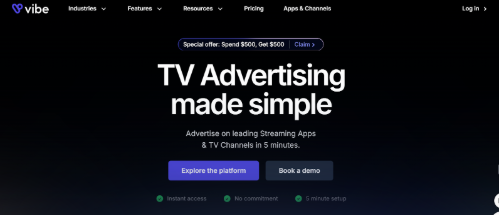
Vibe is a platform designed to make advertising on vMVPDs simple, effective, and accessible for all businesses.
- What Vibe Does: Vibe connects you with premium streaming platforms like YouTube TV and Hulu Live. It takes care of ad placement, targeting, and performance tracking.
- How It Helps: By managing the technical side of things, Vibe allows you to focus on your business. It ensures your ads are shown to the right people, at the right time.
Why Choose Vibe?
Here’s why Vibe is the perfect solution for businesses, especially small and medium ones:
- Precise Targeting: You can easily each the right audience based on their interests and behaviors.
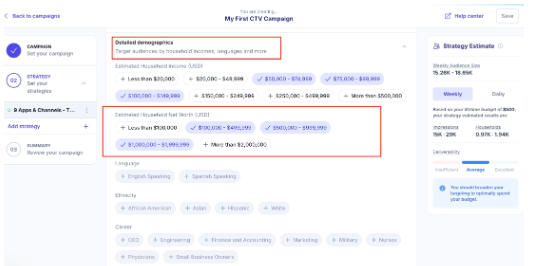
- Time-Saving: Vibe handles the complexities of ad management while you focus on growing your business.
- Actionable Insights: You will get clear performance data to refine and improve your campaigns.

For example, a local gym can use Vibe to run ads during live sports on YouTube TV, targeting fitness enthusiasts in their area. This ensures the gym reaches people who are more likely to convert into customers.
Whether you’re considering MVPD or vMVPD advertising, the right choice depends on your business goals. If you’re aiming for mass visibility, MVPDs might work.
But if precise, cost-effective campaigns are your priority, vMVPDs, powered by tools like Vibe, offer unmatched potential.
Final Verdict: vMVPD or MVPD—Which One Is Right for You?
Choosing between vMVPDs and MVPDs depends on what you need. Let’s break it down simply:
- Who Are vMVPDs Best For?: They’re perfect if you want flexibility, like watching on your phone or TV anywhere with an internet connection. They’re also budget-friendly, making them great for saving money without sacrificing quality.
- Who Are MVPDs Best For?: They’re ideal for those who prefer traditional TV setups or live in areas without reliable internet. They also offer more niche channels, which might matter to some.
For advertisers, vMVPDs is a better option. They let you target specific groups so your ads reach the right people. But managing this can feel tricky.
That’s where Vibe.co helps. We simplify advertising on vMVPDs by handling targeting and tracking so you can focus on growing your business.
Ultimately, vMVPDs are best for modern needs, while MVPDs stick to tradition. Choose wisely what works for you!

